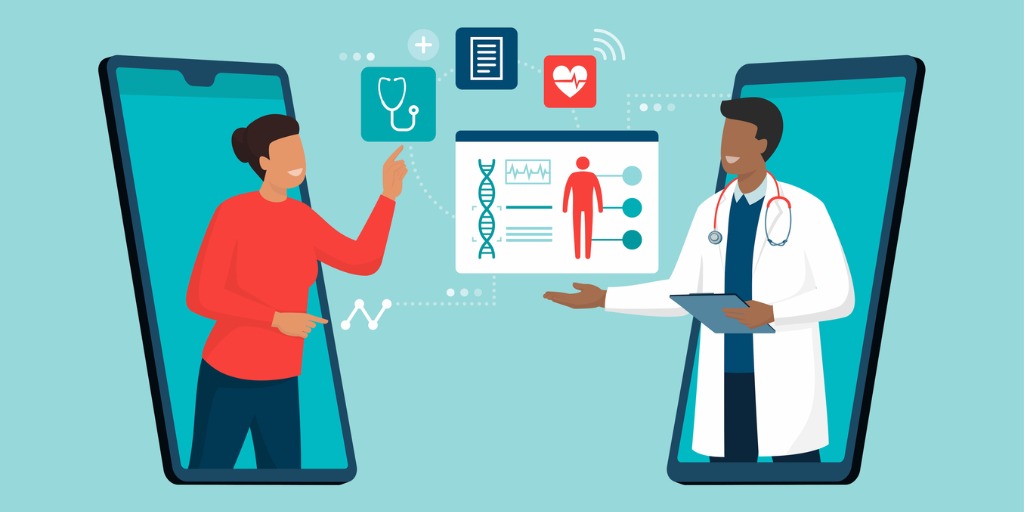Learn how hybrid care is changing the way patients receive health services
At a recent Reuters Event, Lindsay Jubelt, Chief Population Health Officer at Mass General Brigham and Chief Medical Officer at AllWays Health Partners, spoke about the evolution of the hybrid care model. Learn more about how our partnership with Mass General Brigham gives us a direct sightline into patient care—and how we are changing it to revolve around the evolving needs of our members.
What is hybrid care?
Hybrid care combines traditional in-person care and virtual care, ideally the best of both offerings. Technology is at the centerpiece of hybrid care, allowing for video conferencing, patient monitoring, and convenient scheduling—or on-demand care. The pandemic radically transformed healthcare by pushing healthcare out of crowded physician offices and onto virtual platforms. Our health system at Mass General Brigham went from having virtual visits in small pockets of our delivery system—to converting all specialties to virtual care almost overnight.
Pre-pandemic care was centered around providers. Patients traveled to providers, waited in doctor offices, and scheduled care around provider availability. The pandemic introduced a historical healthcare crisis in America, but it also gave us the chance to rethink how we deliver care moving into the digital age. This doesn’t apply everywhere; not all healthcare can be replaced with virtual care, and some patients still prefer in-person visits. Therefore the ideal state is hybrid.
Building hybrid care across the system means redesigning care around the patient. Here are some of the ways patients receive care today:
Episodic or traditional care—a single in-person encounter with a provider in a medical office, typically scheduled.
Telehealth visit—a single encounter with a provider over the phone or video, typically scheduled.
E-visit—an online visit or brief check-in focused on a specific symptom conducted through a patient portal asynchronously. Typically initiated by the patient, they’ll send a message or questionnaire, and the provider responds through email, text, or phone call.
Remote patient monitoring—This is a continuous, ongoing data exchange between the patient and provider or provider’s team.
These are just some of the ways care is shifting from the traditional model. Industries outside of healthcare are already doing this to orient the delivery of service around the consumer. For example, banks don’t require customers to enter a branch to utilize service. This change has been gradually occurring with healthcare, but the pandemic pushed our industry to adopt a consumer-focused business model. The healthcare industry may have been behind, but consumers are not. Today’s patients expect on-demand care, reduced fragmentation, and personalized service based on their health—that come with no surprises.
What are some examples of hybrid care?
- iHeart Champion—A personalized heart disease management program at Brigham & Women’s hospital that’s accessible to members at AllWays Health Partners. iHeart Champion delivers remote patient monitoring and in-person or virtual care options, coordinating PCPs with pharmacies. This program helps patients reduce bad cholesterol, blood pressure, and risk of heart attacks within three to six months and has proven to impact patients’ lives positively.
- Care management—Although this was built as a traditional care management model, the pandemic transitioned the program from in-person to virtual. In response to virtual care barriers for some of our underserved patients who didn’t have video capabilities, we also conducted telephone outreach, and in some cases, provided them with virtual devices.
- AllWays on Teams—In partnership with Microsoft, AllWays on Teams is a free telehealth solution to support our entire network of providers in delivering virtual care. This allowed us to reach over 30,000 of our highest-risk patients during the height of the pandemic. Coming out of the pandemic, we’ve continued with this consultative model to ensure that we provide supportive care for every patient. We also supported COVID-19 testing and facilitation of vaccination appointments with a particular focus on underserved patients.
Given how much we accomplished in a hybrid setting during COVID—identifying what reverts for in-person and what can continue to be virtual will contribute to our expansion of hybrid care through a value-based care model. Value-based care maps out the patient journey to guide the delivery of care. This applies to all members, including high-risk patients and those with chronic conditions. Since hybrid care is not traditionally paid for, payment models will pivot from paying for volume to paying for value, lowering costs to patients. The goal is provider-patient transformation, moving from transactional care—to building long-lasting relationships with accountability for the lifetime of patients’ health. Our partnership with Mass General Brigham supports the evolution of this new delivery model, allowing for a transparent, seamless care journey.
To learn more about supporting your employees with the latest benefits, look at our plans or visit our employer resource page.
You can also read the post-event report to learn how Mass General Brigham is approaching the hybrid care model as part of our value-based care strategy.

